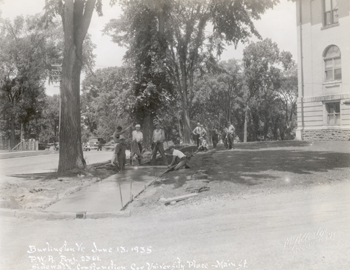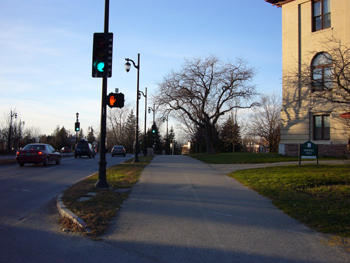


 |
 |
Date: June 13, 1935 |
Date: November, 2006 |
Location: Looking West Toward Morrill Hall From Main Street |
Geographic Position : 180643289E 492639N |
A close look at the caption of the photograph reveals the following: “P.W.A. Proj. 2361.” The Public Works Administration (P.W.A.) implemented numerous federal employment projects aimed at combating unemployment during the Great Depression.[1] According to the Report of the Street Commissioners in the 1934 Annual Report of Burlington, “The Street Department has fallen, in a large measure, the responsibility during the past year, of carrying on various projects aimed to relieve unemployment.”[2] The report then went on to discuss the strenuous burden the additional responsibility has placed on the Street Department.[3] The 1934 Annual Report of Burlington states that the PWA would be responsible for approximately ten miles of new cement concrete sidewalks; the photograph shows one of the following projects.[4] The project cost a total of $50,340.01; federal W.P.A. covered $23,000 of the construction cost.[5] A man with a wheelbarrow, the only person not looking at the camera, can be seen emptying concrete onto the sidewalk. The sidewalk was built in sections with wood separators placed between each section. Men can be seen holding straightedges that smooth and level the poured concrete. On the right-hand side of the photograph, Morrill Hall, designed by the New York architect C. W. Buckham, is visible; the namesake of the building, Justin Smith Morrill, was the author of the Land Grant College Act which was critical for its construction.[6] The land on which Morrill Hall now stands was purchased for approximately $30,000 and the corner stone finally placed by Governor Bell in 1906.[7] Morrill is currently the home of the Agriculture and Life Sciences, as well as the UVM Agricultural Extension Service. On the left-hand side of the photograph rests the University Green; the elm trees were added c. 1833.[8]
[1] William W. Bremer, “Along the ‘American Way’: The New Deal’s Work Relief Programs for the Unemployed,” The Journal of American History 42, no. 3. (1975): 636. [2] City of Burlington, Vermont, Seventieth Annual Report of the City of Burlington, Vermont: For the Year ended December 31, 1934 (Burlington, VT: Free Printing Press, 1934), 151. [3] Ibid, 153. [4] Ibid, 181. [5] City of Burlington, Vermont, Seventieth Annual Report of the City of Burlington, Vermont: For the Year ended December 31, 1934 (Burlington, VT: Free Printing Press, 1934), 185. [6] United States National Park Service, National Register of Historic Places Inventory: UVM Green Historic District, (July 1969). [7] David J. Blow, Historical Guide to Burlington Neighborhoods, ed. Lilian Baker Carlisle (Burlington, VT: Queen City Printers Inc., 1991), 176. [8] Charles E. Allen, About Burlington Vermont (Burlington, VT: Hobart J. Shanley & Company, 1905), 45. |
Morrill Hall, partially visible on the right-hand side of the photograph, has survived intact. Unfortunately, gone are the once ubiquitous American Elm trees that once lined Main Street and University Place. Traffic signals have been since been added to accommodate the heavy flux of pedestrians and vehicles. Tall, lantern-styled lights line Main Street and University Place. |
Historic Burlington Project Depression Era Streetscapes: Old North End | Burlington 1890 | Burlington 1877 | Burlington 1869 | Burlington 1853 | Burlington 1830 Produced by University of Vermont Historic Preservation Program graduate students in HP 206 Researching Historic Structures and Sites - Prof. Thomas Visser - in collaboration with UVM Landscape Change Program Historic images courtesy of University of Vermont Library Special Collections, Louis L. McAllister Photograph Collection |